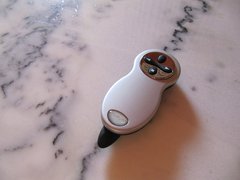The benefits of using a remote control (also called "clicker" or "presenter") to control the advancement of slides in presentation software should be obvious. Mainly, that you can be far away from your laptop and therefore better interact with your audience (instead of with your equipment).
Have you ever wondered how such a remote actually works?
 Technically, remotes (the ones we're talking about here, not the ones for your TV) are very small keyboards with a limited number of keys. The forward and backward buttons simply send the same key codes as the cursor keys on a regular keyboard. The button to blank the screen (if your remote has one) simply sends the letter 'B' (and if you didn't know this, try hitting the 'B' key on your keyboard in your presentation software).
Technically, remotes (the ones we're talking about here, not the ones for your TV) are very small keyboards with a limited number of keys. The forward and backward buttons simply send the same key codes as the cursor keys on a regular keyboard. The button to blank the screen (if your remote has one) simply sends the letter 'B' (and if you didn't know this, try hitting the 'B' key on your keyboard in your presentation software).
Depending on your operating system, you may actually get a notification about a new keyboard being connected to your computer when you use the remote for the first time.
Remotes use either some proprietary connection (the ones that come with a USB dongle) or (more often these days) they use Bluetooth. Bluetooth remotes have to be paired with the device they're meant to control before you can use them, whereas the ones using a USB dongle usually work without pairing.
Remote-controlling Keynote on iOS
Since iOS devices don't have a USB port but do have Bluetooth, you'd think you could simply use a Bluetooth clicker to control Keynote on iOS. Unfortunately, this is not the case.
While you can use an external Bluetooth keyboard to edit your slides in Keynote on iOS, once you switch into presentation mode, the keyboard is ignored. Since, as explained above, a Bluetooth clicker is also just a very small keyboard, this explains why Keynote on iOS will not work with a regular remote.
The only officially supported remote control for the Keynote app on iOS is the Keynote Remote app, running on another iOS device, e.g. an iPhone or an iPod touch. This app uses an undocumented proprietary protocol to communicate between the two devices.
You can see that it is a proprietary solution from the fact that in order to pair the iOS devices, the pairing has to be done in the Keynote app (instead of the iOS system settings app).
I'm not sure why Apple decided to use a proprietary protocol here, but it does have two advantages:
- it works over both WLAN and Bluetooth, whatever's available and more convenient
- you can actually see your slides and speaker notes on the controlling iOS device
The obvious downsides are that you need to own a second iOS device - and that these are much bigger than your average clicker.
Being able to see your slides on your remote is nice, but having to use a relatively large "remote" (with a touch screen) can be awkward and somewhat tiring. I've often wished that Apple would allow the use of a regular Bluetooth remote. The Keynote app for iOS has come a long way since it was first introduced (even remote controlling was a late addition), so maybe it'll happen some day.
While still not a "standard" clicker, there's a solution in the form of the Satechi Bluetooth Smart Pointer. You can read my review of the device elsewhere on this site.
(Photo by yours truly, CC BY)
Please email me for details.

![[Cover: Presenting for Geeks]](/images/thestock/p4g-english-new.png)
![[Cover: Brainstorming Your Presentation]](/images/thestock/bypcover-120.png)